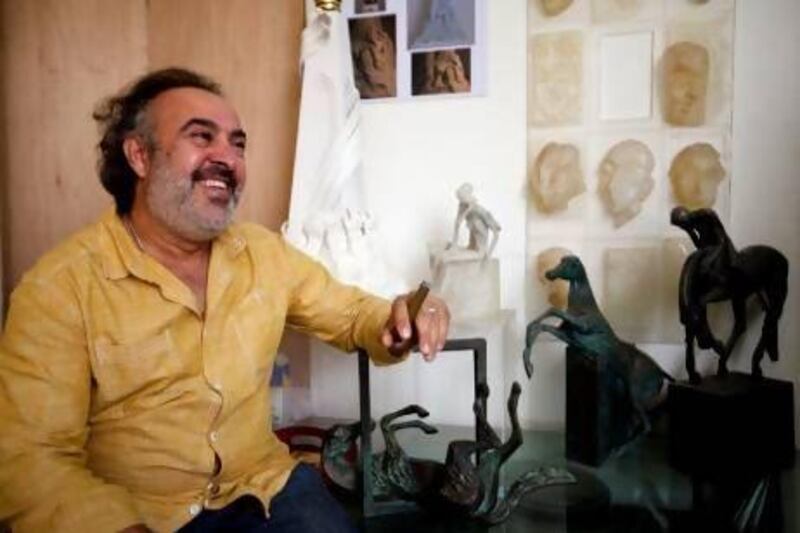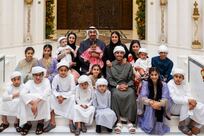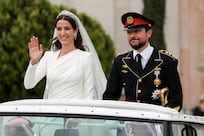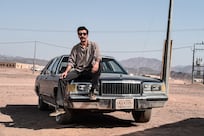Natiq Al Alousi’s art studio in a rundown section of Mussafah is small and modest, a far cry from his high-profile days in Baghdad.
Al Alousi burst onto the Iraq art scene in 1983, when he was just 18, after entering an open art competition called Mandili's Bride Memorial, which attracted some of the country's most prominent artists.
"This competition had some of the most famous artists, like Khaled Al-Rahhal, Suhail Al-Hindawi, and Khaled Izzat, [whose sculpture of Saddam Hussein was famously pulled down by US marines in 2003], so I really don't know how I joined. Even when the minister asked for my name, I couldn't respond, I was just a kid."
Despite his youth and the calibre of the competition, Al Alousi came in third place and received special recognition from the most powerful man in the country.
During the event, Saddam Hussein walked into the room and changed Al Alousi's young life.
"When Saddam Hussein came, he saw the other pieces of works. I was thinking I hope he will come and see my work … back then Saddam was really something," he recalls, speaking mostly in Arabic, his conversation occasionally punctuated by a smattering of English.
"He stood next to me and my artwork, and all of a sudden all eyes and cameras were on me, everyone was just staring at me, it was something surreal. He stood next to my work and he continued to stand there, and until this day, I remember he [Saddam Hussein] said: 'It's very beautiful, it's a great idea'. I want to remember what my reply was, but I can't."
After receiving praise from Saddam, Al Alousi entered numerous competitions that allowed him to share his dynamic sculptures with the public and with the art world. Ismail Fatah Al-Turk, the late Iraqi artist, once said of Al Alousi's sculptures: "Look at his work of art, this is something new and different."
Al Alousi received a silver medal in 1985 from the First Youth Exhibition in Baghdad and was later awarded a diploma from the Sculptors Forum in Budapest, Hungary.
By the late 1980s, with his career on the rise, Al Alousi was commissioned to create several sculptures for Iraq's presidential palaces.
Al Alousi became the manager of the Ministry of Culture and Communication's bronze foundry in the presidential court of Iraq from 1991 until 1996, where he had artists from around the world, including Italy, helping him create institutional sculptures.
While working on his government-commissioned assignments, Al Alousi was still producing his own, more expressive sculptures. "I still continued to do my own signature style in competitions," he says.
"Even when I used to do sculptures for Saddam, I had international networks asking questions about it, but for me, art is not with politics, this is not the topic that I want to get into," Al Alousi says, adding that "it's not political for me, art is part of me."
Al Alousi is not the only artist who has had to answer to authority figures. Famously, Pope Julius II ordered Michelangelo to paint the ceiling of the Sistine Chapel in the 16th century, but the artist initially refused, stating that he was a sculptor, not a painter. Under pressure, both Michelangelo and Al Alousi eventually relented.
"There were competitions for artworks for Saddam. If I won, what could I do?" asks Al Alousi. The artist recalls an instance when he had a proposal for a horse sculpture accepted by the government, and when he refused to drop the price for delivery, he was threatened. It was still an honour, he says, to be hand-picked by powerful figures and asked to create public and private works of art.
"During that era, if Saddam wanted artworks done for him, I couldn't say no. It was something to be proud of, it was something big for any artist to have a commission from any ruler."
His high-profile sculptures include the 10-metre-high Iraqi Jordanian Borders Memorial, the Presidential Site Memorial in Tikrit, which consists of two 10-metre-high sculptures, the Al Mosel Provence Memorial, Al Basra Martyrs' Sculptures, and perhaps his most prominent work, the eight-metre-high bronze flag of Iraq, for the Martyrs' Memorial in Baghdad.
After moving to Abu Dhabi in 2006, life became, to some degree, both tougher and tamer. The fact that there is no bronze foundry in the UAE restricts Al Alousi artistically. Bronze is, he says, where his passion lies. The artist still creates pieces using the alloy, but these works are often initially sculpted in fibreglass, then sent to Egypt to be cast in bronze and finished.
"Here [in the UAE] they don't have bronze, so I have to take my work to Egypt … but unfortunately it's not always good, sometimes it is returned broken."
Today, Al Alousi's sculptures are mainly representations of animal figures such as horses, and small sculptures of the human form.
Prominent in his studio are his sculptures of human relationships and interactions. Al Alousi often represents the female figure as lean, soft and slender, though her face is rarely depicted.
In recent months, Al Alousi's stock has begun to rise once more.
In February and March, he exhibited sculptures and paintings in the Etihad Antiques Gallery as part of the Abu Dhabi Art Squad. On the first day, three of his sculptures were sold.
Al Alousi has also received commissions for palaces and private estates in Jordan and Abu Dhabi. He has also completed reliefs and three-dimensional calligraphy sculptures for Abu Dhabi Pension Fund and life-size bronze sculptures of horses for a member of Abu Dhabi's royal family.
Whether or not Al Alousi has commissions to work on, he still prefers to spend time in his workshop.
"I am not the type of person who lazes around," he says. "I work 24/7, and even if I have no work to do, I will still come and just sit here."
The small studio in Mussafah is clearly Al Alousi's sanctuary, where he can freely express his emotions through just about any medium.
"An artist should not only rely on one piece of material, wherever he can find something, he'll use it.
"An artist can work with different materials, from wood to marble.
"I can't live without art," he says, "I will die. Just like how a person breathes, for me, it's art."
Yasmine Al-Kuttab is an editorial intern at The National.





